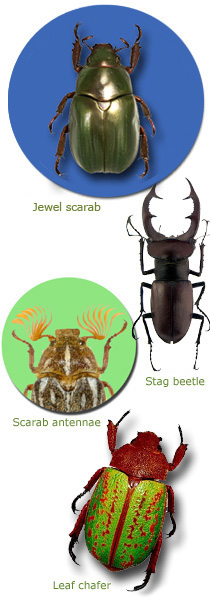 X
X
X
|
|
Scarab beetles are found across our planet, even living in animal burrows in the Arctic. They include the stag beetles that look like they have antlers, the June bugs that buzz around lights at night, the Jewel scarabs that are metallic silver, gold, and green and look like jewelry, the tumble bugs that roll dung balls on the ground, and the rhinoceros beetles that have large and elaborate horns. Scarab beetles range in size from 1 mm to 160mm! Worldwide there are more than 35,000 species. In the United States and Canada there are about 2,000 species.
Scarabs are insects, like butterflies, dragonflies, ants, flies, and grasshoppers. They have three body regions: head, thorax, and abdomen. Many scarabs have horns on their head that can be used to dig a hole or defend food or a mate. Compound eyes are located on the head. Some scarab eyes are very large and help for navigating at night. Scarabs detect smells with their antennae which are located on the head. Scarab beetles have unusual antennae, the tip of which can be opened like a fan. The thorax of the scarab includes six legs. Depending on the scarab’s life style, the legs are modified for digging, running, or grasping. The thorax also includes the flight wings and these are usually protected under the scarab’s front pair of wings which are called elytra. The elytra protect the scarab from predators. The abdomen of the scarab is mostly hidden by the elytra. Scarabs breathe using their spiracles, and these are located on the sides of the abdomen.
But, when you find a beetle, how can you tell if it's definetely a scarab? Well, you have to look at its antennae. Like it was mentioned before, the antennae have a tip or club that can be opened like a fan. No other group of beetles have this characteristic. Just remember to look very closely because scarabs have the ability to open and close their antennae clubs, the same way you, with your hands, can spread or gather your fingers together. |
